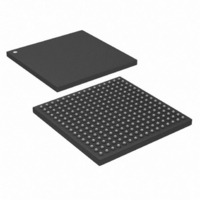DS26514GN+ Maxim Integrated Products, DS26514GN+ Datasheet - Page 70

DS26514GN+
Manufacturer Part Number
DS26514GN+
Description
IC TXRX T1/E1/J1 4PORT 256-CSBGA
Manufacturer
Maxim Integrated Products
Type
Transceiverr
Datasheet
1.DS26514GN.pdf
(305 pages)
Specifications of DS26514GN+
Number Of Drivers/receivers
4/4
Protocol
Ethernet
Voltage - Supply
3.14 V ~ 3.47 V
Mounting Type
Surface Mount
Package / Case
256-CSBGA
Lead Free Status / RoHS Status
Lead free / RoHS Compliant
- Current page: 70 of 305
- Download datasheet (2Mb)
9.9.11 Transmit Per-Channel Idle Code Generation
Channel data can be replaced by an idle code on a per-channel basis in the transmit and receive directions.
The Transmit Idle Code Definition Registers (TIDR1–32) are provided to set the 8-bit idle code for each channel.
The Transmit Channel Idle Code Enable registers (TCICE1–4) are used to enable idle code replacement on a per-
channel basis.
9.9.12 Receive Per-Channel Idle Code Insertion
Channel data can be replaced by an idle code on a per-channel basis in the transmit and receive directions. The
Receive Idle Code Definition Registers (RIDR1–32) are provided to set the 8-bit idle code for each channel. The
Receive Channel Idle Code Enable Registers (RCICE1–4) are used to enable idle code replacement on a per-
channel basis.
9.9.13 Per-Channel Loopback
The Per-Channel Loopback Enable Registers (PCL1–4) determine which channels (if any) from the backplane
should be replaced with the data from the receive side or in other words, off of the T1 or E1 line. If this loopback is
enabled, then transmit and receive clocks and frame syncs must be synchronized. One method to accomplish this
would be to tie RCLKn to TCLKn and RFSYNCn to TSYNCn. There are no restrictions on which channels can be
looped back or on how many channels can be looped back.
Each of the bit positions in PCL1–4) represents a DS0 channel in the outgoing frame. When these bits are set to a
one, data from the corresponding receive channel will replace the data on TSERn for that channel.
9.9.14 E1 G.706 Intermediate CRC-4 Updating (E1 Mode Only)
The DS26514 can implement the G.706 CRC-4 recalculation at intermediate path points. When this mode is
enabled, the data stream presented at TSERn will already have the FAS/NFAS, CRC multiframe alignment word,
and CRC-4 checksum in time slot 0. The user can modify the Sa-bit positions and this change in data content will
be used to modify the CRC-4 checksum. This modification, however, will not corrupt any error information the
original CRC-4 checksum may contain. In this mode of operation, TSYNCn must be configured to multiframe mode.
The data at TSERn must be aligned to the TSYNCn signal. If TSYNCn is an input then the user must assert
TSYNCn aligned at the beginning of the multiframe relative to TSERn. If TSYNCn is an output, the user must
multiframe align the data presented to TSERn. This mode is enabled with the TCR3.0 control bit (CRC4R). Note
that the E1 transmitter must already be enabled for CRC insertion with the TCR1.0 control bit (TCRC4). See
9-16.
Figure 9-16. CRC-4 Recalculate Method
Rev: 101608
TTIPn/TRINGn
INSERT
NEW CRC-4
CODE
EXTRACT
OLD CRC-4
CODE
+
CRC-4
CALCULATOR
XOR
DS26514 4-Port T1/E1/J1 Transceiver
NEW Sa-BIT
DATA
MODIFY
Sa-BIT
POSITIONS
TSERn
70 of 305
Figure
Related parts for DS26514GN+
Image
Part Number
Description
Manufacturer
Datasheet
Request
R

Part Number:
Description:
4-port T1/e1/j1 Transceiver
Manufacturer:
Maxim Integrated Products, Inc.
Datasheet:

Part Number:
Description:
power light source LUXEON® Collimator
Manufacturer:
LUMILEDS [Lumileds Lighting Company]
Datasheet:

Part Number:
Description:
MAX7528KCWPMaxim Integrated Products [CMOS Dual 8-Bit Buffered Multiplying DACs]
Manufacturer:
Maxim Integrated Products
Datasheet:

Part Number:
Description:
Single +5V, fully integrated, 1.25Gbps laser diode driver.
Manufacturer:
Maxim Integrated Products
Datasheet:

Part Number:
Description:
Single +5V, fully integrated, 155Mbps laser diode driver.
Manufacturer:
Maxim Integrated Products
Datasheet:

Part Number:
Description:
VRD11/VRD10, K8 Rev F 2/3/4-Phase PWM Controllers with Integrated Dual MOSFET Drivers
Manufacturer:
Maxim Integrated Products
Datasheet:

Part Number:
Description:
Highly Integrated Level 2 SMBus Battery Chargers
Manufacturer:
Maxim Integrated Products
Datasheet:

Part Number:
Description:
Current Monitor and Accumulator with Integrated Sense Resistor; ; Temperature Range: -40°C to +85°C
Manufacturer:
Maxim Integrated Products

Part Number:
Description:
TSSOP 14/A°/RS-485 Transceivers with Integrated 100O/120O Termination Resis
Manufacturer:
Maxim Integrated Products

Part Number:
Description:
TSSOP 14/A°/RS-485 Transceivers with Integrated 100O/120O Termination Resis
Manufacturer:
Maxim Integrated Products

Part Number:
Description:
QFN 16/A°/AC-DC and DC-DC Peak-Current-Mode Converters with Integrated Step
Manufacturer:
Maxim Integrated Products

Part Number:
Description:
TDFN/A/65V, 1A, 600KHZ, SYNCHRONOUS STEP-DOWN REGULATOR WITH INTEGRATED SWI
Manufacturer:
Maxim Integrated Products

Part Number:
Description:
Integrated Temperature Controller f
Manufacturer:
Maxim Integrated Products

Part Number:
Description:
SOT23-6/I°/45MHz to 650MHz, Integrated IF VCOs with Differential Output
Manufacturer:
Maxim Integrated Products










